
In the wake of high-profile launches, numerous legacy and DTC retailers have met content disaster. Can content marketing succeed in the paid-media-dominated world of ecommerce trends?
If so, how do you create a strategy that aligns with and serves the funnel? What tactics and KPIs matter: search engine ranking, direct and assisted conversions, or some intangible kinship between buyer and “brand”?
Above all… is there hope amid the wasteland?
The graveyard is growing. And the undertaker’s been busy.
Setting aside historical harbingers — most notably, Boo.com and Thrillist-JackThreads unraveling— the last half-decade has witnessed a host of legacy and DTC organizations fund, launch, and shutter large-scale content strategies.
From a Darwinian view, the toll includes mainstream names like GoPro, Coca Cola’s “Journey,” Style.com, Flex’s The Fixx, and Casper — not once, but twice over.1 On the audio front, both Away and Wing’s podcasts lasted a single season. As for print, Goop (officially) ASOS (officially), and Bumble Mag (unofficially)2 have ceased publication.
Outright closures are only part of the story.
While still technically “alive,” Harry’s Five O’Clock hasn’t posted a new article since Sept.,3 with the next most recent dated Apr. 2018. Schmidt’s The Natural abandoned its social channels in Mar. of last year. And Outdoor Voices’ The Recreationalist, unveiled as a community platform in mid-2019, boasts 14 forum comments in total.
In short, never before have so many ecommerce companies produced so much ecommerce content marketing with such little attention to ecommerce results.
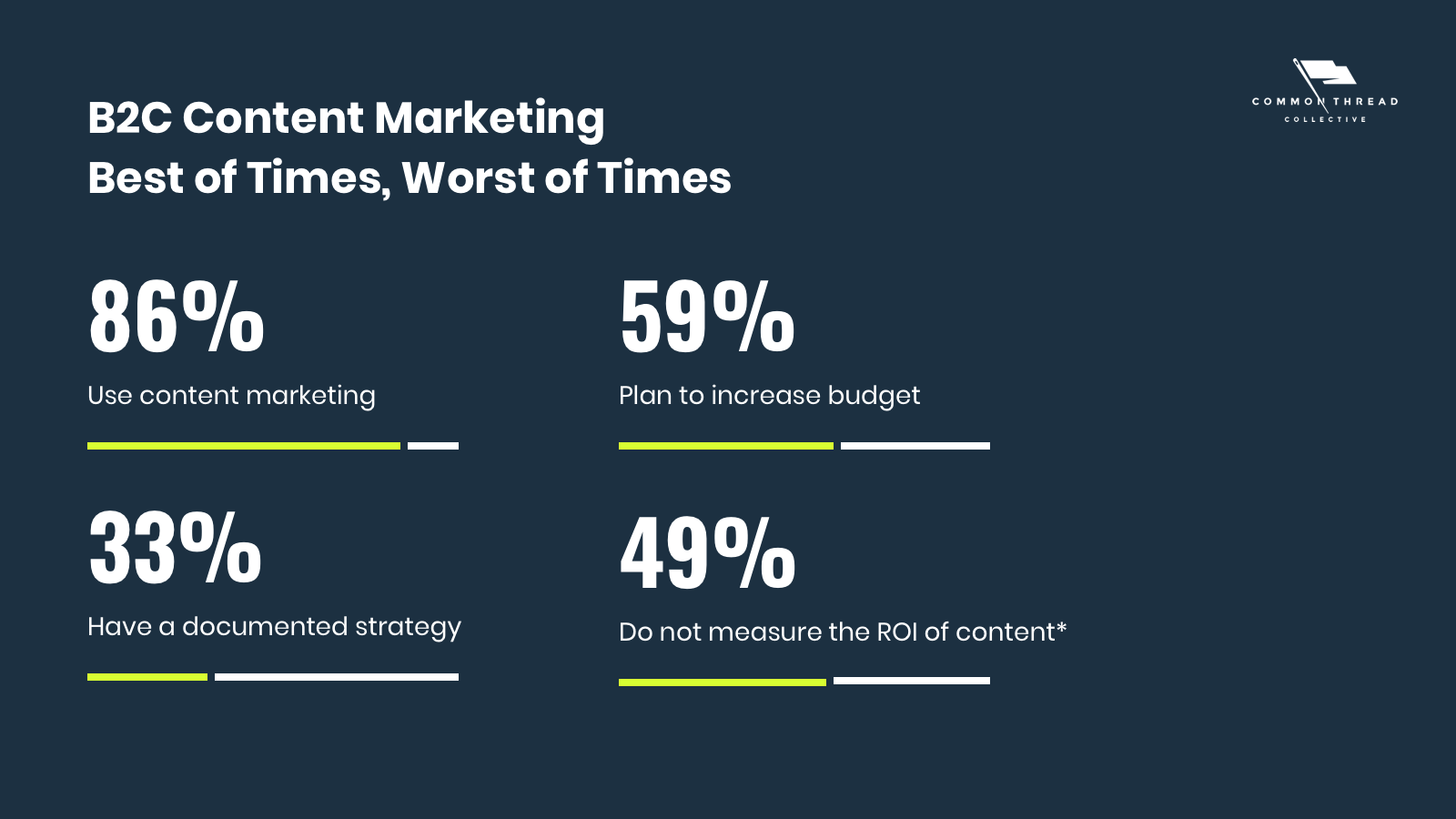
Against this backdrop, two questions press hard.
First, why the continued focus on content and commerce? Second, does content really work?

“For brands and digital publishers alike, organic audiences are the new communities,” Web Smith, Founder of 2PM Inc, told me. “These digital relationships can equate to longevity and depth over time while improving LTV and reducing CAC.”
In other words, answering the first question is easy enough: organic audiences compose the Holy Grail of digital shoppers. The second is far thornier.
Thankfully, 10 brands hold out hope, each with a proven lesson:
- Thinx: Create Like a ‘Person’ to Build a Cross-Channel Community
- Dollar Shave Club: Covet Thy Freedom and Only Serve One Master
- FC Goods & Beardbrand: Explain What It Is, Then Connect the Story
- Pura Vida Bracelets & LaserAway: Help the Macros ‘Influence’ the Micros
- Tracksmith: Run a Paid War Chest Off Organic Storytelling
- The Hundreds: Play the Long-Game in Your Native Tongue
- Chubbies & OUI the People: Love, Laughter & Language, Email That Isn’t ‘Marketing’
Don’t have time to read it now? No problem.
We’ve put this entire article into a single PDF with all the data, examples, lessons, and original quotes from the brands listed above.

Create Like a ‘Person’ to Build a Cross-Channel Community
To viewers, Thinx’s first national TV campaign may have felt like a bold gamble from a DTC upstart. To its customers, the spot was a natural culmination of the brand’s overarching narrative.

In and through its ecommerce site, blogs, product pages, social accounts, IRL meetups, and email, Thinx trumpets one refrain: normalizing what the wider culture calls abnormal.
“At Thinx, we essentially approach our brand as though it is a person,” said Hilary Fischer-Groban, Thinx’s Brand Director. “We need to have a high level of familiarity with our potential customers so that they are comfortable trusting us with something as personal as their periods.”

“The end goal of our content strategy is to be seen as a robust resource for our community on the topics of periods, bladder leaks, and menstrual equity — we are here to answer all of the questions that come in, as well as have the foresight to know what areas need more education.”
To maintain candidness and consistency across its channels, Thinx abandons euphemisms and shame. In lieu of product-centricity, the aim is to enable its audience “to take control of these conversations and give them more in-depth understanding and awareness, while sourcing a diverse range of perspectives.”
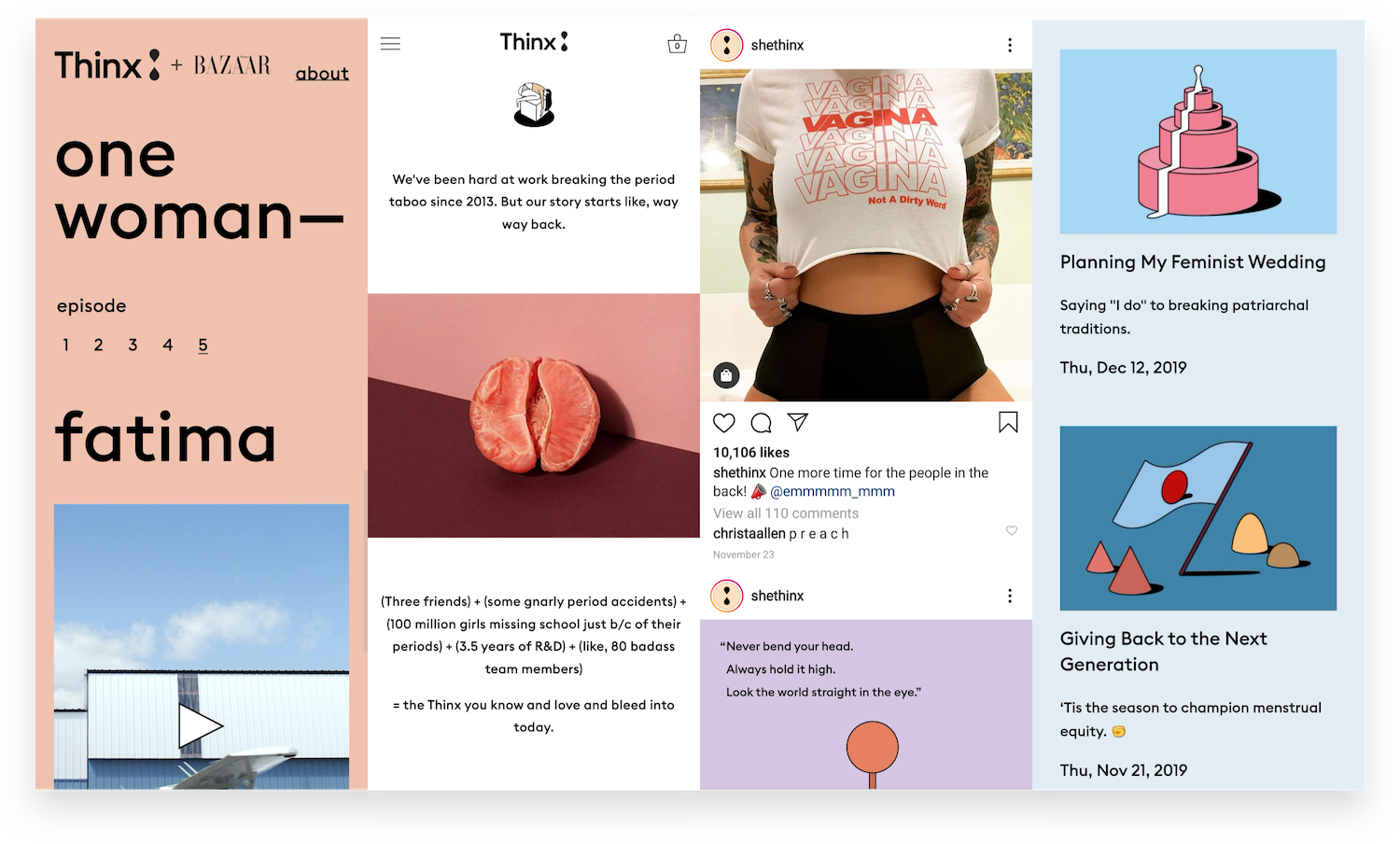
Of course, none of this means abandoning metrics.
“Thinx is a very data-driven company,” noted Fischer-Groban. “All teams spend significant time reviewing the performance of their content — whether it be our blog, our Instagram account, or our digital ads — to determine what is performing well, how much traffic we are driving, how the community is engaging, and also how many sales we can see as a result.”
It does, however, require balance. While metrics like SEO, conversion rates, and engagement determine success, “not every type of content that builds community will drive revenue, and vice versa, and we know that both types are important and offer value to our community.”
Lesson: Enter Their Story with Your Story
Valuable content centers on the story your audience already inhabits, entering it not as the hero but as a human helper. Pick that story wisely and tell it honestly, no matter the medium on which it appears.
Covet Thy Freedom and Only Serve One Master (at a Time)
At the opposite end of the gender spectrum stands Dollar Shave Club’s Mel Magazine. The online publication runs the gamut between long-form articles, listicles, interviews, video content, and a topical section bluntly labeled, “DICKS.”

Originally launched in 2015 as a twice-a-week newsletter, Mel defies the usual definitions of “branded” or “sponsored” content. Rather than a thinly veiled extension of Dollar Shave Club or its parent company, Unilever, Mel’s team operates with a near-miraculous level of editorial freedom.

“At MEL, no one from the brand approves our stuff,” said Alana Hope Levinson in a 2019 interview. “Part of the deal is we are given carte blanche to run a men’s magazine however we want; I’ve never even had a story reviewed or killed by the CEO. I have more freedom to do what I want here than I ever had at ‘traditional’ media outlets because we aren’t feeding the beast of traffic and advertising.”
Or, in the words of editor-in-chief, Josh Schollmeyer: “The heartbeat, or north star, never changed much… [to be] a different men’s publication that was much more intellectually curious than it necessarily was consumer-based. We are hoping to make a meaningful contribution to the evolution of men.”
Laid side-by-side with Harry’s Five O’Clock, Mel’s independence and journalistic standards stand in stark relief:
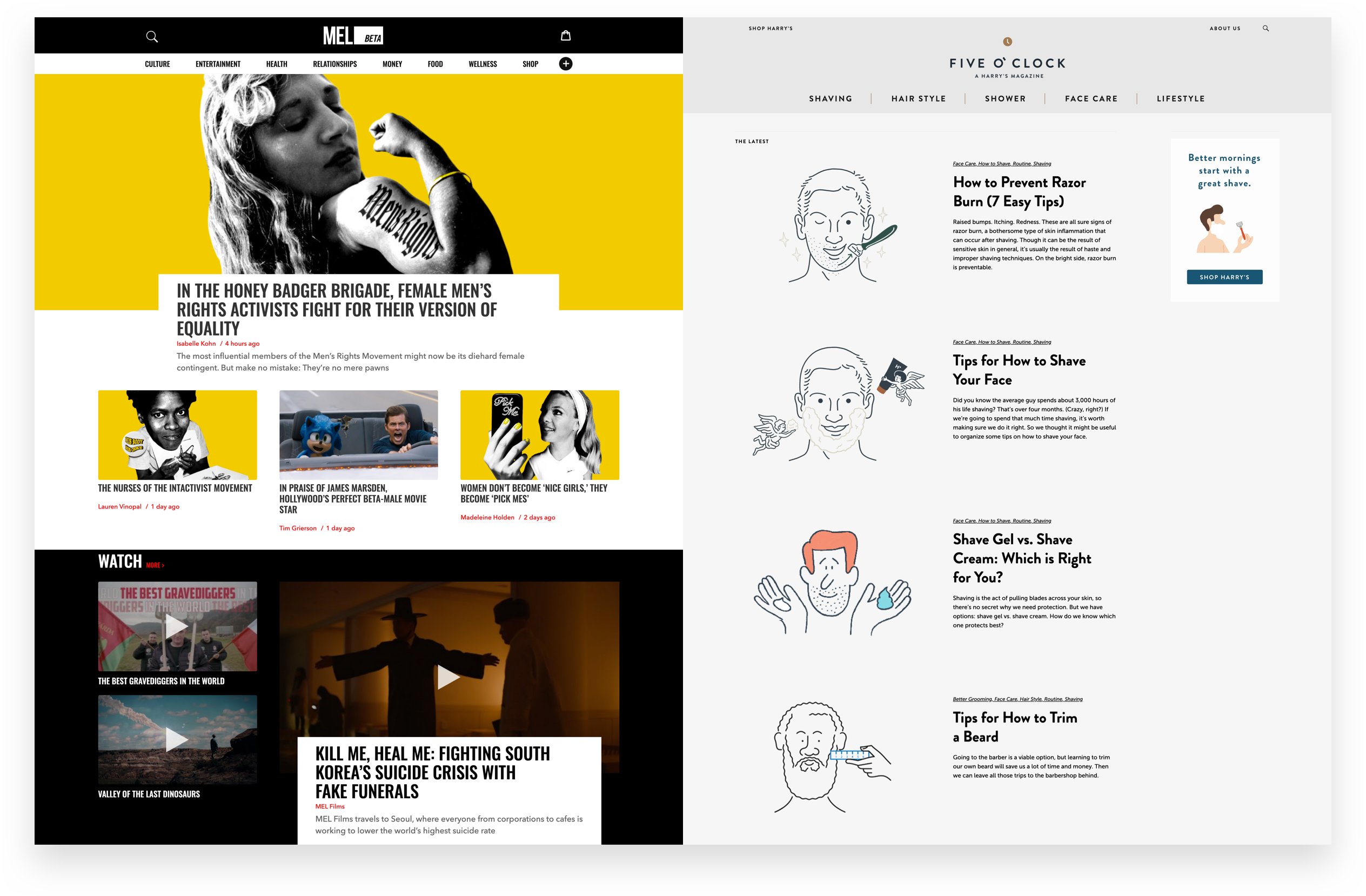
Looking from the outside in, its strategy has racked up impressive numbers…
Data from third-party aggregators4 puts monthly traffic at ~2M unique visitors with seasonal spikes as high as 2.5M. Mel’s 2,231 articles published over the last 12 months add up to 421,572 social-media shares and 2,457 backlinks.
As for length, those same +2k articles clock in at an average of 1,522 words with outliers — like The Men’s Guide to Abortion and In the Honey Badger Brigade: Female Men’s Rights Activists Fight for Their Version of Equality — beyond 7,000 words.
This isn’t to say Dollar Shave Club doesn’t produce ecommerce blogging. “We have original content and then we have Mel, which [has] no Dollar Shave Club advertising — it has editorial independence,” explained CEO, Michael Dubin.
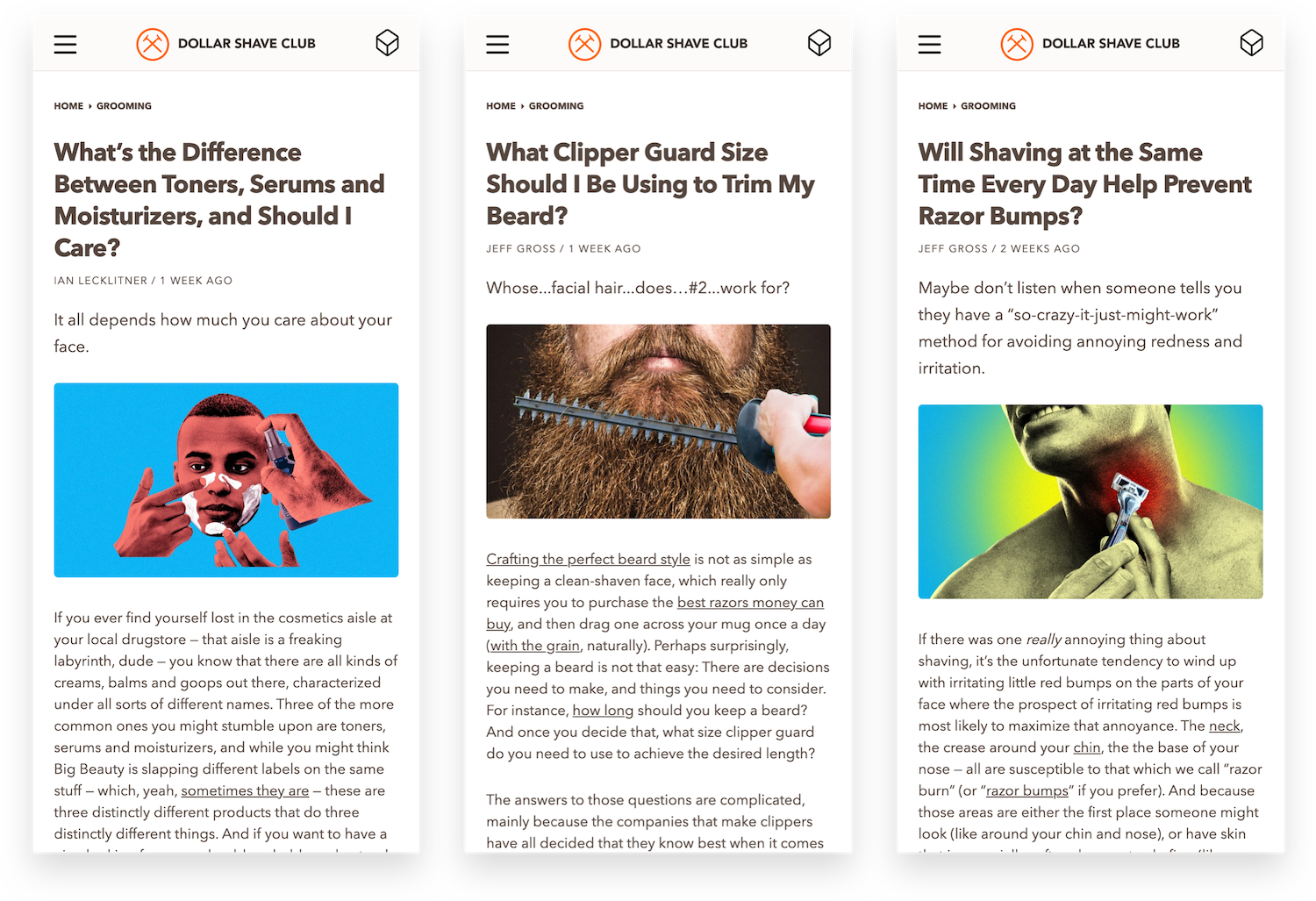
Lesson: Free Yourself by Separating Yourself
There’s nothing wrong with product content (as we’ll see next). Nonetheless, your strategy cannot serve two masters; ironically, freeing it from “the beast of traffic and advertising” can unlock both.
‘Product’ Content: Explain What It Is, Then Connect the Story
FC Goods was struggling. Not only with an account that refused to yield positive returns but with sales, period. The company sells vintage baseball gloves upcycled into men’s accessories. With a team composed of ex-baseball players, the roadblocks were surprising.
“We were plagued by questions,” said CEO, Andrew Faris. “Was it product-market fit? The landing pages, ad placements, or audiences? Should we turn to Google Ads or Amazon for discovery?”
The answer came in a single video, produced in its designer’s garage in just a few minutes. Originally shot not to be an ad, its only goal was to present the product onsite in as simple and clear terms as possible.
Immediately, the video struck a chord — first, organically; then, through paid. “We eventually scaled spend 10X our usual budget, while holding a 2.0 ROAS,” said Faris.
More than that, the video served as an internal breakthrough: “Content is a core strategy that we’ll be leaning on to grow FC Goods and the other two DTC brands I oversee to $12 million in 2020 revenue. Our plan is to continue the momentum, something we were skeptical of until the power of explanatory content was driven home.”
For medium retailers without deep pockets, it’s a lesson that bears amplification. Beardbrand, for instance — whose annual revenue is in the “upper seven figures” — generates content on two YouTube channels, its blog, Facebook, Instagram, and Twitter.

“We put our primary focus on YouTube as a platform,” said Eric Bandholz, Beardbrand’s founder. “Depending on how the channels perform, we may extend the time between an upload or adjust which content we send up next. That being said, we typically aim three or four videos per week on our organic channels.”
With 1.45 million YouTube subscribers and a handful of non-product hits, Beardbrand’s staples are long-form explainer videos featuring its products in action. Beardbrand then repurposes those organic shoots in various lengths and cuts for paid marketing campaigns.
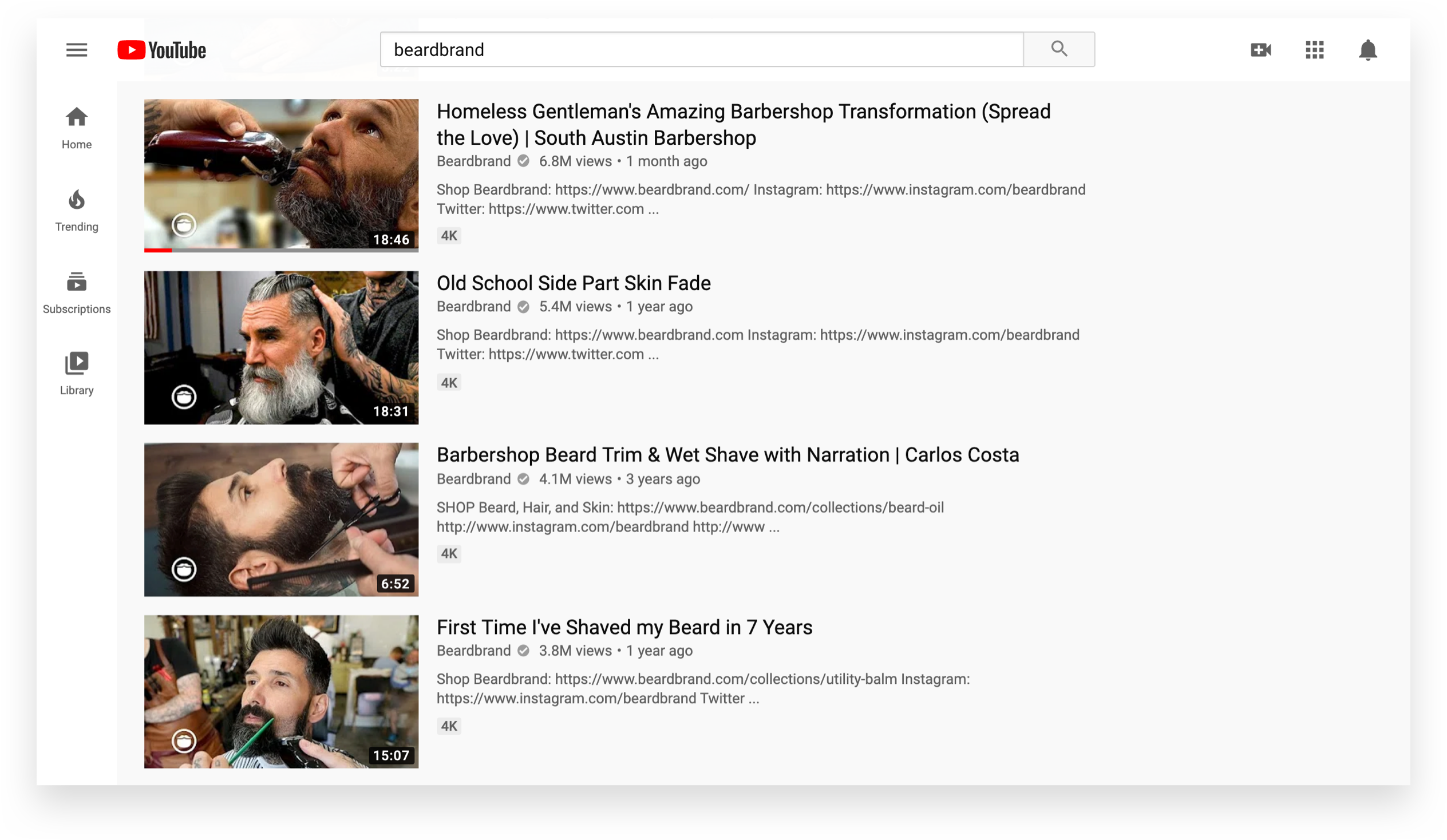
The returns have been handsome. YouTube videos account for 36% of Beardbrand’s current customer base, followed by word of mouth (18%), search (14%), and ads (13%).
“Like any type of digital marketing,” said Bandholz, “you’re not going to see success if you try something once and give up on it. If you want to get onto YouTube, I’d recommend only doing it if you feel confident you can create at least 20 videos without any inspiration.”
Man, it's been really fun to build the Beardbrand Alliance channel back from dead.
— Eric Bandholz (@bandholz) December 18, 2019
Since September:
> 47 videos
> 25k Subscribers
> ~600k Views
This is how you grow a YouTube channel. Patience, lots of content, and learning from what you made.
Shout outs: Greg, Carlos & Ben. pic.twitter.com/OrEUSJa1iC
Lesson: Show, Tell & Make It Obvious
Before venturing into non-product publishing, wise brands set a foundation to answer commonly asked questions. Video content and infographics lend themselves particularly well to this goal. Moreover, videos can then segue brilliantly into the story in which your product shines.
Help the Macros ‘Influence’ the Micros
Pura Vida Bracelets is a juggernaut — Instagram’s most engaged jewelry brand of 2019, Forbes 30 Under 30 founders, and a multi-million-dollar acquisition. Partnerships with mega-influencers have been a staple of Pura Vida’s growth. Still, the secret to its social-driven content success lies in an army of micro-influencers, over 275,000 strong.

“We started working with select brand ambassadors early on,” explained Pura Vida’s CEO and co-founder, Griffin Thall. “Like us, they were small. So it was more about creating content, developing relationships, and guerrilla marketing. We grew with them side-by-side and, a couple of years ago, began creating co-branded bracelet packs so the marketing had a genuinely shared purpose.”
While today its influencers range from a few hundred thousand followers to a few million, the company developed its dominance organically — with a focus on community. From there, the move to reps, referrals, and ambassadors was natural, though not without a clear structure:
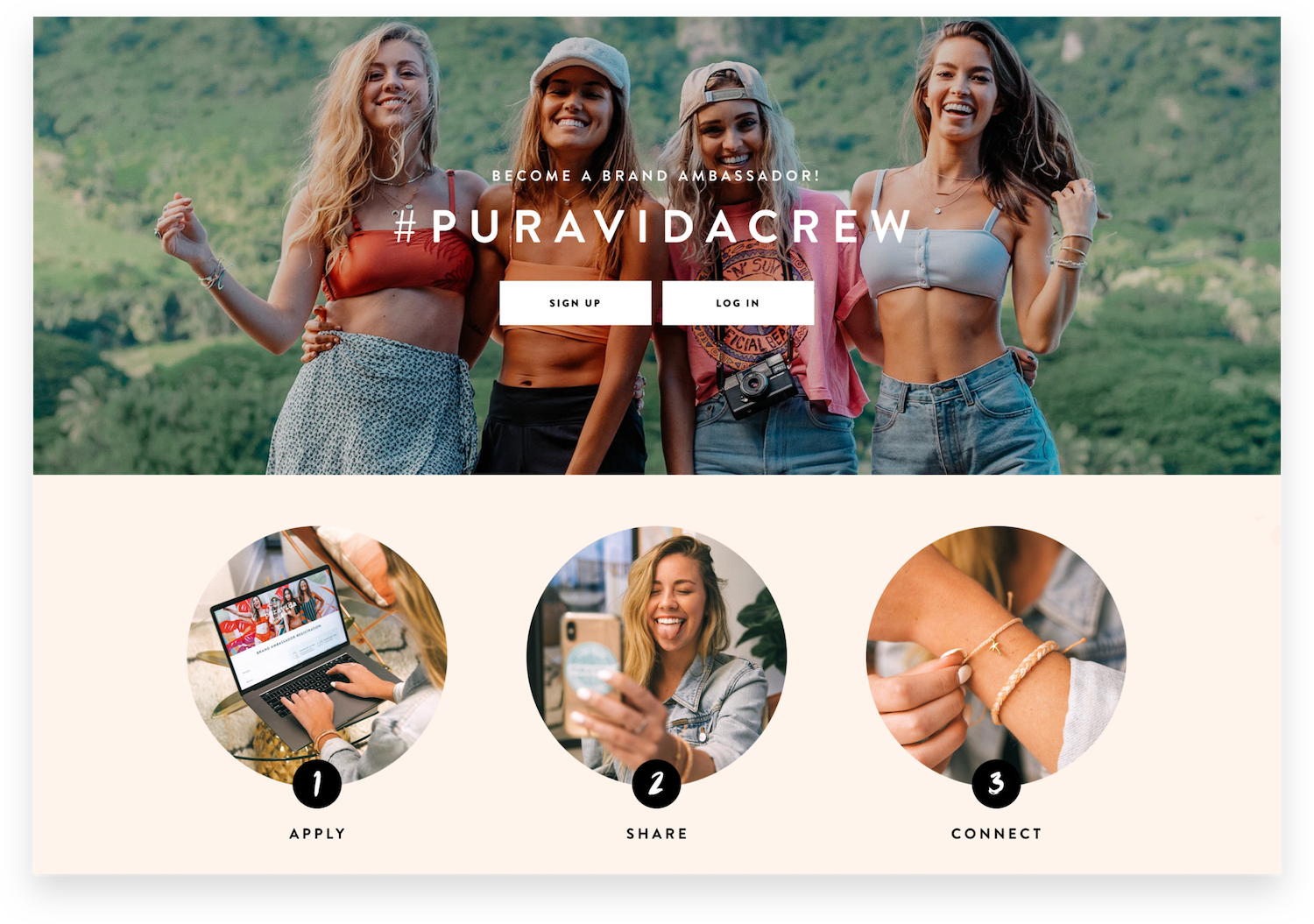
The true genius of Pura Vida’s approach lies in how it weaves the two groups together.
Multiple times a week, Pura Vida’s influencers host live training sessions on a private Instagram account. “We hired Courtney Steeves,” said Thall, “who was already producing content for us as an influencer, to teach our ambassadors how to not just get more out of the program but how to shoot and create more effective content themselves.”
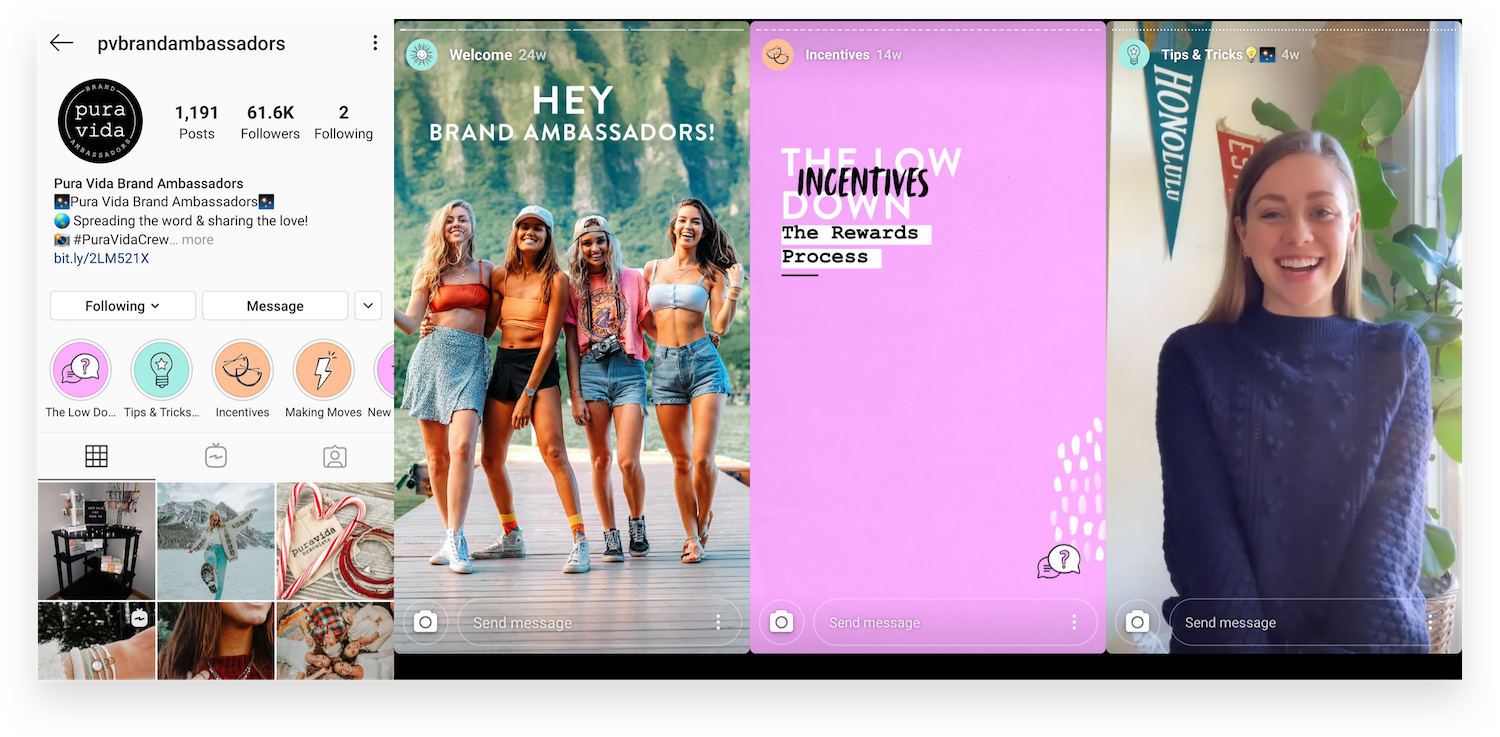
“We don’t think of ourselves as media publishers. Our creative basically comes from an in-house small team taking our influencers on trips through the year and just documenting everything. That plus our team taking product pictures and the UGC is pretty much the whole content strategy.”
The result has been an outpouring of content and engagement in the program that now drives ~5% of Pura Vida’s overall revenue independent of paid efforts. What’s more, the program is tied directly to its subscription package, which itself drives another ~15% of the company’s revenue.
Lesson: Turn Influencers into Production Centers
The future of social commerce is native. Already, the power of influencer marketing lies not so much in its ability to drive traffic and sales (though it can), but as a center for content production and audience development — regardless of an influence’s size.

“Micro-influencer campaigns are a great method to (1) maintain an ongoing organic social conversation, (2) build out a highly-converting content library, and (3) expand your audience pool within the exact niche you’re targeting.”
Taylor Lagace, Co-Founder of Kynship
Given what a rich and cost-effective resource micro-influencers are for content creation, how can you structure them effectively?
- Start with an organic deliverable such as IG stories where your brand not only benefits from influencer posts but also reserves the right to repurpose them across all marketing channels
- Contract each micro-influencer to two videos, one photo, as well as advertiser access to their social handles to serve FB/IG sponsored ads from their pages
- Have the creator post only one video as the IG story; the rest of the content should be retained to use across all marketing mediums — particularly, your paid media mix
That strategy served as the blueprint for LaserAway’s ongoing success with Kynship — an influencer marketing agency. “What began as a CPA target of $40, eventually achieved a CPA of $17 overall,” explained Lagace, “Kimbyrleigha’s content [left below] when targeting her look-alike audiences of 2.4 million people, became the top-converting audience.”
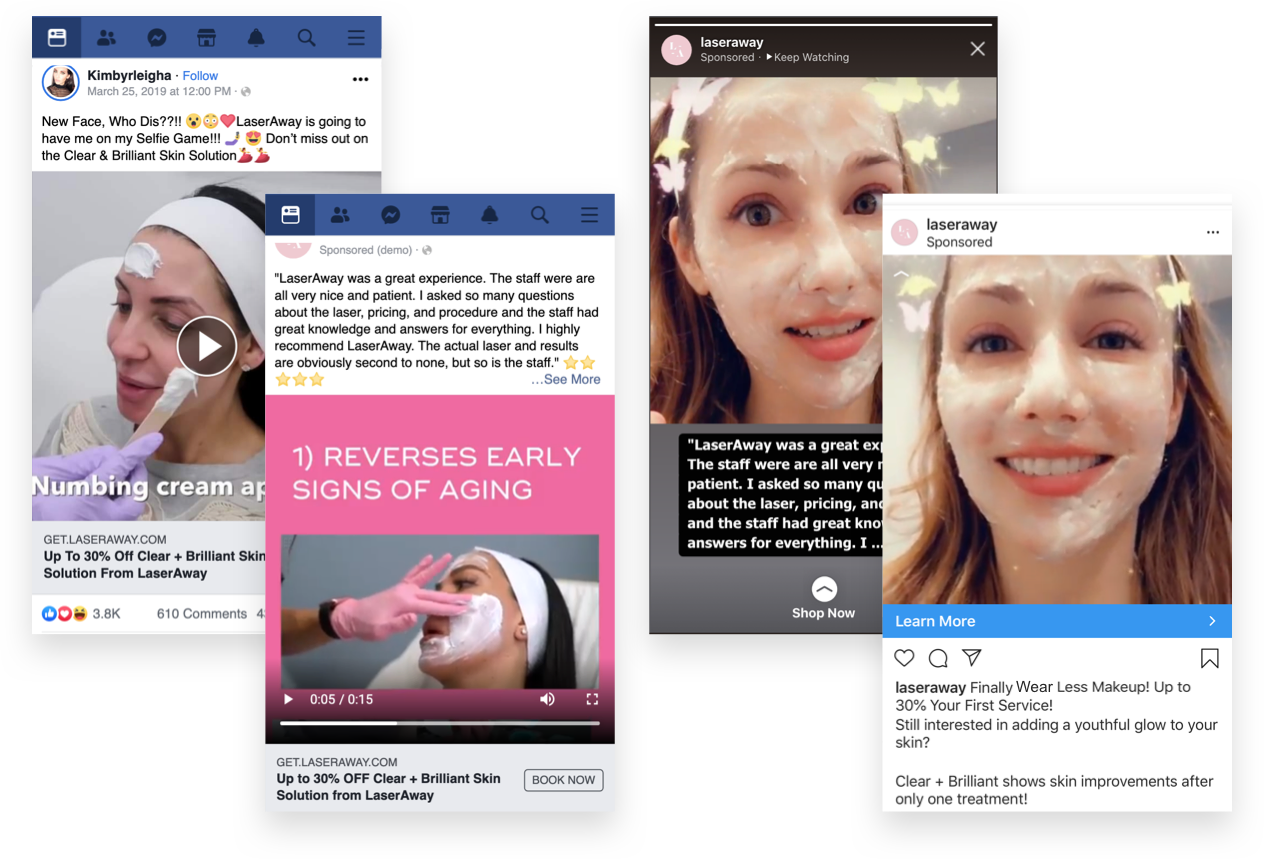
Executed correctly, these partnerships not only fuel the need for organic content and paid assets but also generate vast audience pools for low-cost targeting. People follow macro-influencers for a variety of reasons; they follow micro-influencers, for one or two specific reasons.
That specificity conspires to make content that resonates within the very communities a brand aims to serve.
Run a Paid War Chest Off Organic Storytelling
Tracksmith’s commitment to aesthetics has quickly become the stuff of modern legend. Everything from its collection-launching lookbooks to its print magazine (Meter) to its membership program breathes the mantra: “Race day is sacred.”
And yet, to revel in Tracksmith’s organic use of photography and words would be to miss an unexpected asset: a social-media advertising war chest few brands can compete with.
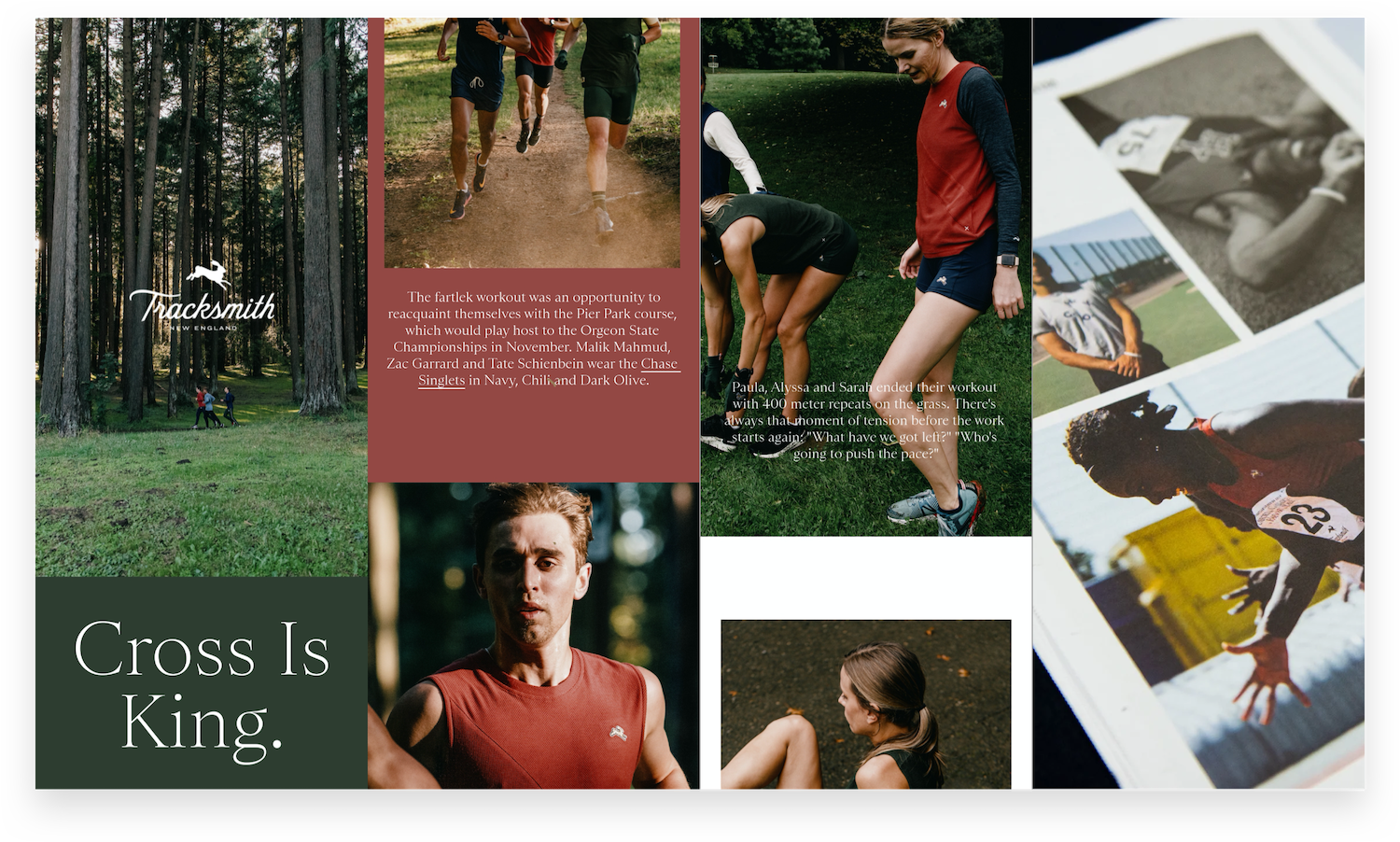

“Content and storytelling have been integral to the brand’s DNA,” said founder, Matt Taylor. “All too often you see these sanitized photos of runners that lack emotion or connection to the sport’s glory. So, we set out to capture the beauty inherent in the exhaustion of training and the exhilaration of racing.”
Tactically, this means working with amateur runners to photograph and film them during actual workouts, whether a 20-mile run or an 8-mile tempo. It’s a commitment that requires more investment than most make. But, it also serves as a repository for the brand’s paid initiatives.
“I’ve always looked at content as the main driver for our advertising,” noted Taylor.
“Brands that do content and commerce best understand that when the story comes first, the rest follows.”
No Days Off Calendar is a microcosm of that strategy. On one hand, it’s an organic word-of-mouth vehicle that customers hang up in offices and homes as well as share on social. At the same time, Tracksmith heavily features it in its winter advertising campaigns:
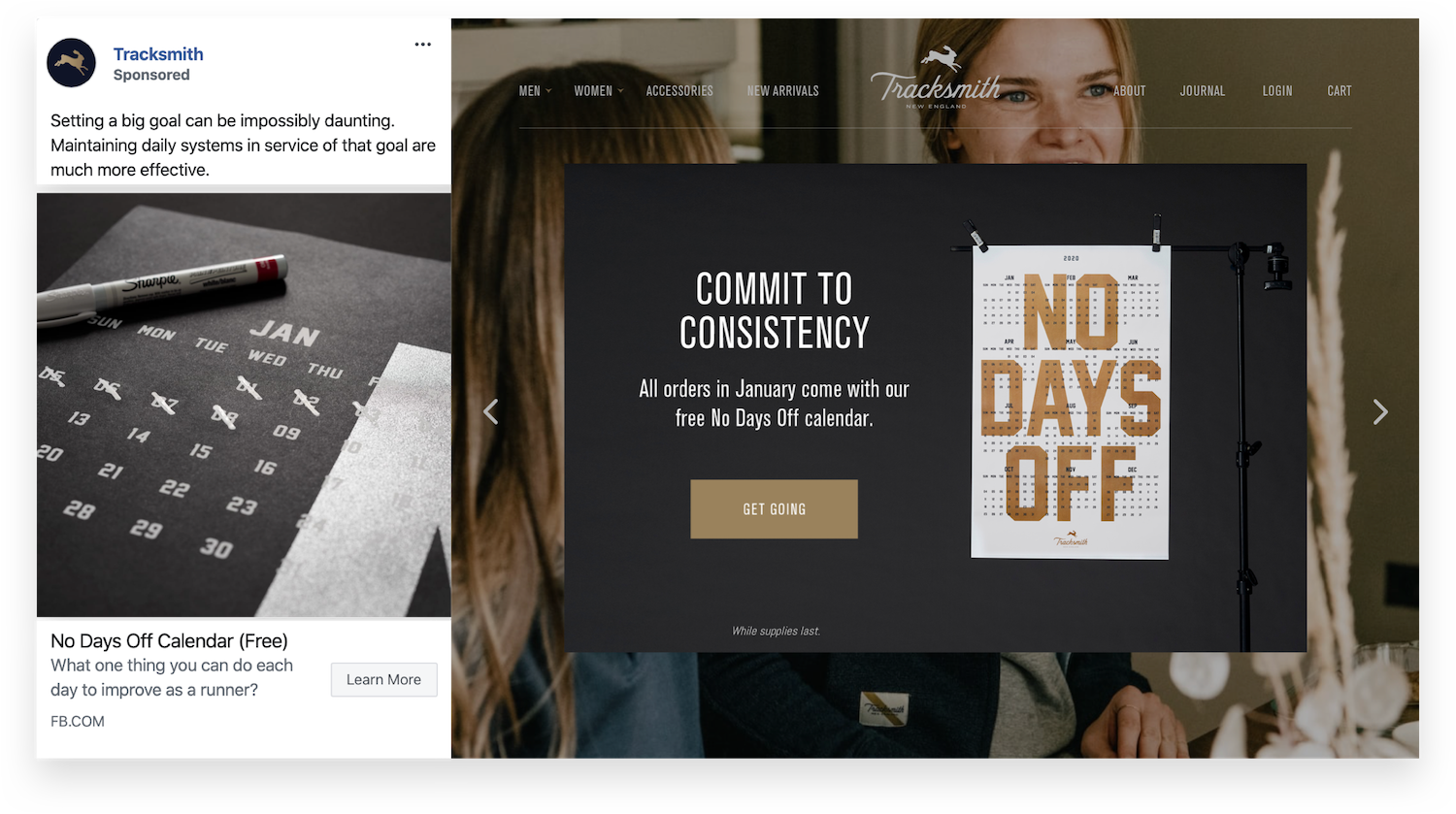
Lesson: Make Peace, Win the War
Paid and organic — performance and brand — need not be pitted against each other. Instead, the latter (in particular, visually rich storytelling) should form a unique advantage in the former’s competitive landscape.
Play the Long-Game in Your Native Tongue
“We’re not a T-shirt brand,” Bobby Hundreds has famously quipped. “This is content and culture and community. The T-shirt is just merch.” That ethos has been so central to the rise of Bobby’s streetwear brand, The Hundreds, that earlier this year he enshrined a variant of it as the title of his book, This Is Not a T-Shirt.

“I’m a storyteller first and foremost,” says Bobby. “I don’t just use my words, I use photography, film, T-shirt graphics, and apparel to convey that narrative. It’s a part of my nature and how I engage with the world.”
The hub of The Hundreds is its blog; back in 2003, that’s where the company got its differentiated start. From inception, products were never just pieces of clothing: they carried a message and story.

As for developing a strategy, in Bobby’s words: “Only do it if you have an insatiable and genuine curiosity about the subject matter. I can’t help but share the news, and I’m constantly intrigued, perplexed, and inspired by the people I meet around me. I feel compelled to tell their stories. And in doing so, I share mine.”
Lesson: Rig the (Content) Game in Your Favor
To grow an audience, content is a long game. Adopting any strategy that doesn’t naturally fit your passion will devour you. Instead, focus on what you couldn’t help but create, irrespective of products.
Love, Laughter & Language: Email Marketing That Isn’t ‘Marketing’
It’s a general rule that ecommerce businesses love email. Despite the rise of all things “channels,” email marketing remains the single-highest ROI medium of customer retention and lifetime value.
And, customers… hate it. Bombarded by sales messages, it’s become social media fodder:
In the last 65 days, Bombas has sent me 24 emails. 23/24 were 100% product or sales based.
— Kristen LaFrance (@kdlafrance) November 13, 2019
That's roughly one PRODUCT #email every 2.5 days for the last 2 months.
I opened 3/24 (mass opened all today for image) and clicked on 1/23.
This is dangerous.
<thread> pic.twitter.com/ZZrUlo4Gxe
How do you make your emails cut through the noise? Hire a comedian. We’re not joking; that’s what Chubbies did.
“When I started here, I was having a conversation with the founders about how the marketing voice developed,” Joey Avery told The Unofficial Shopify Podcast last year. “They basically were thinking: ‘We just want this to sound like your most fun group chat.’”
Avery might seem like an odd choice for an Ecommerce Content Manager at one of DTC’s fastest-growing brands — a comedian with no marketing experience. But his creative unlock was not to think about creation as making ads; instead (through his native voice), he framed it as creating comedy.
From witty subject lines to outrageous videos, gifs, and puns, comedy is what its audience expects. And what Chubbies delivers.

Aside from promotional campaigns, every Friday Chubbies sends out “The Weekender.” It’s meant as a message to spice up the inbox – highlighting events, seasonal celebrations, and off-beat products rather than its highest-selling SKUs.
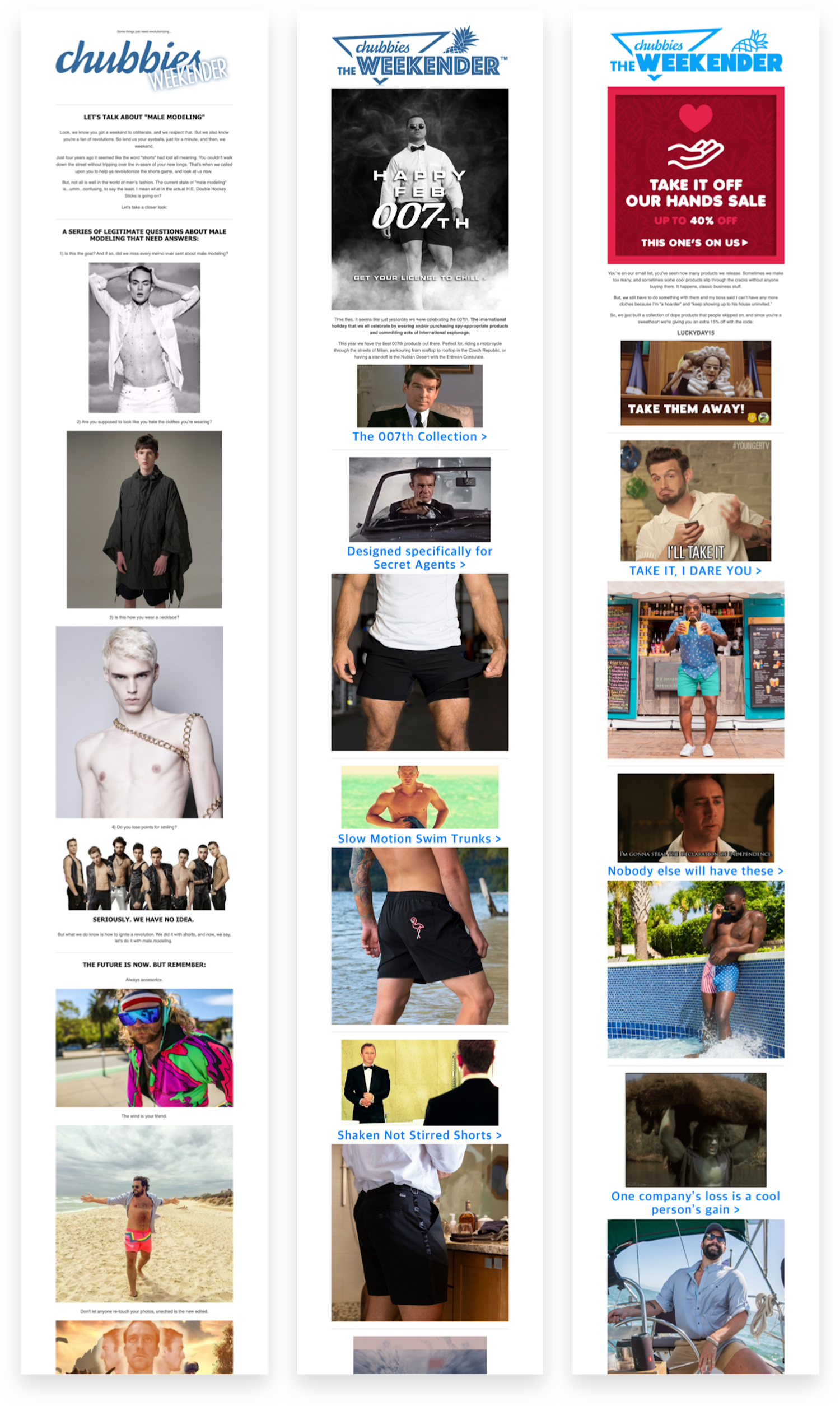
Combined with its equally hilarious social-media presence, the strategy creates a personality around the brand that is entertaining and engaging. And, fans expect it. So much so that, when “The Weekender” is sent, its fans tweet out screenshots of the email creative or chat about their favorite joke.

“The one thing we always try to do no matter what email we’re sending is, even if it’s about a product or just about something cool that we found, we still want it to be a fun different moment of email reading from what you’re doing most of the time,” said Avery in a 2019 interview.
But, what if you’re not funny?
The takeaway from Chubbies isn’t that you need to hire a comedian. It’s about finding your voice and owning it.
Non-humor-based brands can follow the same principle: Darn Good Yarn and its commitment to artisans in India; Love Wellness and education; or OUI the People and the reConstitution of beauty.
“We’re a team of two,” Karen Young, CEO of OUI the People, told me. “For emails, I work primarily on copy and apply our knowledge of how the customer is processing concerns throughout the funnel. Dana, our brand director, makes sure the voice, ethos, and aesthetic is translated throughout.”
“In our case, that’s an undertone of humor, a powerful dose of color, and our informative perspective. Our audience is curious about processes, ingredients, and adamant about efficacy so we try to translate that in most, if not all, emails.”

“The reConstitution of Beauty is our pledge that in the process of marketing to and creating for our community, we won’t degrade them.”

How? Similar to Thinx, OUI the People watches its language in all facets of communication. “At the highest level,” says Young, “it’s building a brand from a position of respect for our customers. It then reverberates through the brand, messaging, and product development.”
Lesson: Make Email Great Again
By setting the tone and delivering on expectations, email marketing can transcend transactions while still driving revenue. Not by going outside the box, but by innovating within it: yours and theirs.
Light Amidst the Darkness: An Ecommerce Content Marketing Strategy that Works
Can content and commerce be profitably united? Certainly.
In fact, to lament the failures is as much a danger as to laud the winners. After all, ads, products, and PR campaigns fail every day, but nobody’s talking about the death of marketing writ large.

“Brands must get out of two mindsets,” said Robert Rose, Chief Strategy Officer of TCA: The Content Advisory, “first, a random collection of assets and, second, a one-off campaign governed by the same metrics as any other initiative. Instead, think of content the way you would a portfolio of products or investments — thematically connected, scalable, manageable, and risk mitigated.”
Approaching “content and commerce” as a late-entry arbitrage for customer acquisition is headed for heartache… regardless of how well-funded or celebrated it might be at launch.
What unites those proving content’s worth are (1) a creative strategy born from and for the community it serves and (2) buy-in at the founder or executive level that sees content as an extension of the brand itself.
Other benefits can help: namely, a rich repository for paid ad creative, a reverse-engineered source of influence, and a vehicle for personality that makes marketing not feel like marketing. That last benefit is especially critical for social justice issues — i.e., Juneteenth marketing.
For owners and operators at $2M-$30M ecommerce stores, these examples may feel overwhelming.
One more demand on an already crushing to-do list.
If that’s you, perhaps it’s best to end on two notes. First, by returning to the aspirational words of Bobby Hundreds: “Only do it if you have an insatiable and genuine curiosity about the subject matter.”
And second, with the tactical words of my friend David Herrmann:
“In paid, it doesn’t matter how good your strategies are. Your audience needs to connect with your content first. It’s the kindling. It’s what drives inspiration. I can’t make people money unless they keep feeding me content.
“If sales are down, if traffic is more expensive, blame content.”
Footnotes
1. For Van Winkle’s shutdown, see Digiday; Wolly Magazine’s status is a bit murkier, clicking “Buy Magazine” on the current site redirects to Casper’s homepage and Woolly’s most-recent social post is from Oct. 2018
2. Beyond Apr. press coverage, Bumble Magazine appears to have only one live URL, which ends in CTAs to “Open Bumble” or “Download the app” and does not contain links to any issues or subscription options.
3. Oddly, that’s when five “How to” articles appeared simultaneously shortly after Five O’Clock was redirected to a subdomain (as per The Wayback Machine).
4. Data sources on Mel Magazine were compiled from Alexa, SimilarWeb, Buzzsumo, SEMrush, and Ahrefs
We won't send spam. Unsubscribe at any time.

Previously the VP of Marketing at CTC and Editor in Chief of Shopify Plus, Aaron is now the Head of Marketing at Recart SMS. His content has appeared on Forbes, Mashable, Entrepreneur, Business Insider, The New York Times, and more. Connect with Aaron on Twitter or LinkedIn.